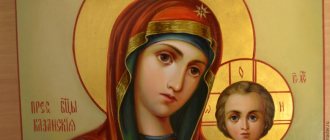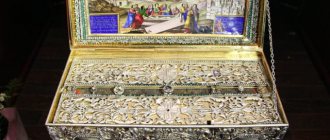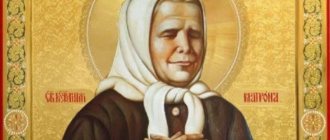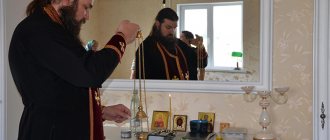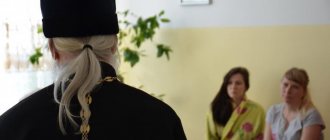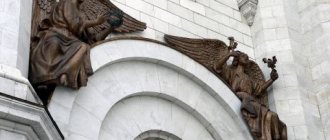The priest is not a sorcerer and cannot perform miracles. But at the same time, he is the successor of the apostolic tradition, the representative of Christ on earth. Every real, sincere priest is not a source, but a conductor of God’s grace.
Many believers realize this and would be glad to receive the blessing of a priest, but are embarrassed to approach him. This is not from modesty, but from the fact that people simply do not know how to behave when meeting the priest.
It is useful for a believer to know such things so as not to deny himself what every Orthodox Christian has the right to.
A blessing is a form of greeting or approval, as well as a ritual act
Blessing is a multifaceted phenomenon. It carries several functions at once.
The blessing gesture contains the name of Jesus Christ
Function 1. In the Orthodox tradition, priests and laity greet differently. When church ministers of equal rank meet, they may say something like “The Lord is between us,” or use another form of greeting.
If a layman or a priest of lower rank greets the priest, everything is different.
A blessing is a form of greeting.
Function 2. You can deliberately meet with a priest and ask him to attract the grace of God. If the priest considers that a person is really asking for a blessing for a charitable deed, he will approve the request. Moreover, this should not be regarded as the action of one specific church minister. A righteous priest speaks on behalf of the Church, and the Church speaks on behalf of God. That is, the blessing of a priest is a direct attraction of the Holy Spirit into a person’s life.
Blessing is approval of any activity.
Function 3. There are various forms of religious asceticism: fasting, repeated reading of akathists, etc. Not all of them are allowed to be undertaken without the approval of a clergyman. There are also controversial prayers in Orthodoxy, for example, the prayer to Saint War. You can read them only with the blessing of the priest.
Blessing is permission for spiritual achievement.
Function 4. In such cases, you don’t need to think about how to ask for a blessing. It is already given. The priest simply says to everyone: “The grace of our Lord...”, “The blessing of the Lord be upon you,” etc. He can sign the sign of the cross with parishioners with some church objects in his hand. People are only required to cross themselves and bow.
The blessing is part of the church service.
Recommendations
- Encyclopedia of Jewish Studies
.
16
. Keter Publishing House and in New York by Macmillan. 1972. p. 513. - Nulman, Macy, Encyclopedia of Jewish Prayer
(1993, New Jersey, Jason Aronson) sv Birkat Kohanim, p. 109;
Gold, Avi, Birhas Kohanim
(1981, Brooklyn, Mesorah Publications), pages 28–29; Jastrow, Marcus. “Dictionary of Targumim, Talmud Babli, Talmud Yerushalmi and Midrashic Literature” (Hreb, 1926) sv “dukhan” p. 285 - "The second day of Yom Tov for the Israelis." Journal of Halacha and Modern Society
. Staten Island, New York: Yeshiva Rabbi Jacob Joseph School (46): 119. 2003. - Numbers 6:23–27. Found in Parshat Naso, 35th Weekly Torah portion of the annual cycle.
- Liturgical Perspectives: Prayer and Poetry in Light of the Dead Sea Scrolls... By Orion Center for the Study of the Dead Sea Scrolls and Related Literature.
International Symposium . item 243. - Clyde M. Woods, Justin Rogers (2006). Leviticus and numbers
. College Press. p. 218.CS1 maint: uses the authors parameter (communication) - Numbers 6:27.
- Yael Landman Vermouth (April 13, 2016). "Smoke, a priestly blessing in inscription and scripture." Review of the Ancient Hebrews. Review Smock, Jeremy D. (2016). Priestly Blessing in Inscription and Scripture: The Early History of Numbers 6:24–26
. Oxford: Oxford University Press. - Gold, Avi, Birkas Kohanim
(1981, Brooklyn, Mesorah Publications) pp. 90 and 94;
Elbogen, Ismar, The Jewish Liturgy: A Comprehensive History
(orig. 1913, English translation 1993, Philadelphia, Jewish Publication Society) p. 64, citing Mishnah,
Megillah
4:4. - Gold, Avi, Birkas Kohanim
(1981, Brooklyn, Mesorah Publications) p. 94;
for this reason the blessing is not performed during the daytime service of the holiday (as opposed to fasting), Nulman, Macy, Encyclopedia of Jewish Prayer
(1993, New Jersey, Jason Aronson), pages 109–110;
Sperling, Abraham, The Reasons for Jewish Customs and Traditions [Ta-amei ha-Minhagim]
(orig. 1890, English translation 1968, New York, Bloch Publishing Co.) p. 67 (quoted
Orach Hayyim
129:1) - Gold, Avi, Birkas Kohanim
(1981, Brooklyn, Mesorah Publications) p. 95; The duration of menstruation depends on the deceased relative. - Gold, Avi, Birkas Kohanim
(1981, Brooklyn, Mesorah Publications) p. 90; but the kohen is required to recite the blessing only once a day, so the kohen may refuse a request to perform the blessing a second time on the same day. - Gold, Avi, Birkas Kohanim
(1981, Brooklyn, Mesorah Publications), pp. 94–95. - Nulman, Macy, Encyclopedia of Jewish Prayer
(1993, New Jersey, Jason Aronson), p. 111, citing Zohar,
Naso
147b, and the koans themselves preface the blessing with their own prayer, thanking God for commanding them to “bless His people Israel , love." - Nulman, Macy, Encyclopedia of Jewish Prayer
(1993, New Jersey, Jason Aronson) p. 111;
Orot-Sephardic Everyday Siddur
(1994, New Jersey, Orot Inc.) p. 178;
Elbogen, Ismar, Jewish Liturgy: A Comprehensive History
(orig. 1913, English translation 1993, Philadelphia, Jewish Publication Society) p. 63 (“The priests did not begin by themselves, but the regent had to ask a blessing before them, and this custom so deeply rooted that it is considered a rule of the Torah (quoted by
Sifre
, Numbers, sec. 39)" - Mansour, Eli. “Does the Kohen who serves as Hazzan recite Birkat Kohanim?” DailyHalacha.com
. Torah Learning Resources Ltd. Retrieved March 10, 2013. - Wed The Complete ArtScroll Siddur
(Ashkenaz Publishing, 2nd ed., 1987, Brooklyn), p. 923;
Gold, Avi, Birkas Kohanim
(1981, Brooklyn, Mesorah Publications), pages 43 and 69. - Nulman, Macy, Encyclopedia of Jewish Prayer
(1993, New Jersey, Jason Aronson), 112;
Elbogen, Ismar, The Jewish Liturgy: A Comprehensive History
(orig. 1913, English translation 1993, Philadelphia, Jewish Publication Society) p. 64;
The Complete ArtScroll Siddur
(Ashkenaz Publishing, 2nd ed., 1987, Brooklyn), p. 295. - See, for example, Leonard Nimoy, Live Long and Prosper
(The Shekinah Comes Down and Looking at It Can Seriously Injure or Kill a Person); Birhat Kohanim ("The Divine presence will shine on the fingers of the Kohanim, as they bless the Jews, and no one was allowed to look out of respect for God"). - Nulman, Macy, Encyclopedia of Jewish Prayer
(1993, New Jersey, Jason Aronson) p. 110;
Gold, Avi, Birkas Kohanim
(1981, Brooklyn, Mesorah Publications) p. 95;
Orot-Sephardic Everyday Siddur
(1994, New Jersey, Orot Inc.), pages 178 and 181. - Nulman, Macy, Encyclopedia of Jewish Prayer
(1993, New Jersey, Jason Aronson) p. 110 - Sperling, Abraham, The Causes of Jewish Customs and Traditions [Ta-amei ha-Minhagim]
(orig. 1890, English translation 1968, New York, Bloch Publishing Co.), pages 62–63. - During the First Temple period, people wore silver scrolls inscribed with Birkhat Kohanim as amulets, as described in the article. Ketef Hinnom.
- "עוד בעניין נשיאת-כפיים בארץ-ישראל, הנחת הידיים ב'מודה אני'" [More about wearing hands in Eretz Israel] ( in Hebrew). Chabad of Israel. בצפאת-כפיים רק במוסף שבת [1]
- Nulman, Macy, Encyclopedia of Jewish Prayer
(1993, New Jersey, Jason Aronson), pages 109–110;
Elbogen, Ismar, The Jewish Liturgy: A Comprehensive History
(orig. 1913, English translation 1993, Philadelphia, Jewish Publication Society), pages 64–66. - Nulman, Macy, Encyclopedia of Jewish Prayer
(1993, New Jersey, Jason Aronson) p. 109;
Gold, Avi, Birkas Kohanim
(1981, Brooklyn, Mesorah Publications), pages 37–38. - Nulman, Macy, Encyclopedia of Jewish Prayer
(1993, New Jersey, Jason Aronson), pages 109–110; Although Yom Kippur is a solemn occasion, Neil's service provides a sense of hope and optimism about Divine forgiveness. - Nulman, Macy, Encyclopedia of Jewish Prayer
(1993, New Jersey, Jason Aronson), pages 110–111, although the Zohar and Vilna Gaon had clear instructions for the leader to turn left and right at certain words. - Gold, Avi, Birkas Kohanim
(1981, Brooklyn, Mesorah Publications), p. 41. - Parsons, John. "Priestly blessing." Hebrew for Christians
. - Rabinowitz, Mayer. "OH 128:2.1994a Women raise your hands" (PDF). CTLS responses 1991-2000.
. pp. 9–12. In the archive (PDF) from the original dated March 20, 2009. - Rabbis Stanley Bramnick and Judah Kagen, 1994; and responsa from the Vaad Halacha Masorti movement, Rabbi Reuven Hammer, 5748
- Kol Haneshama Sahabat Vagim
, Reconstructionist Press, Wyncote, PA, 1994, p. 348 (footnote 2) - "Shabbat at Home" (PDF). Reform Judaism.
- "The Priest at the Final Rite of the Mass." The Holy See
. Retrieved August 13, 2022. The biblical source is referred to as "Numbers 6:23-26." - "Regular Worship > Regular Material > New Worship Models > Resource Section > Conclusion > J67." Church of England
. Retrieved August 13, 2022. The biblical source is referred to as "Numbers 6:24,25." - "Book of Common Prayer: Order for Visiting the Sick" (PDF). John Baskerville, via the Archbishop Justus Society. 1762 [1662]. p. 184. May the Lord bless you and keep you. The Lord will make His face shine on you and have mercy on you. The Lord will lift up His face upon you and give you peace now and forever.
- “The Lord bless you and keep you” (PDF). Musica Sacra of Sarasota. Archived from the original (PDF) on 2014-03-29. Retrieved 2014-03-28.
- Block, Ernest. “Ivarekha adonai.” Sacred Service (Avodat Hakodesh)
. Milken Archive of Jewish Music. - The 1983 television show Leonard Nimoy's Star Trek Memories. The story was told on camera by Nimoy and repeated in somewhat shortened form in the 1999 Sci-Fi Channel Special Edition commentary track for the episode "Amok Time". Once again, Nimoy told this story on camera.
- Jeffey, Nathan (September 25, 2009). "'Hallelujah in Tel Aviv: Leonard Cohen Inspires Diverse Crowd." Forward
.
There are no special moments to take a blessing, you just need to use common sense
Blessings can be taken in a variety of circumstances:
- Chance meeting. Most often this is done when meeting a priest on the street.
- They specially find a priest in the temple. You can wait a very long time to encounter a priest on the street. And if you need to enlist the support of higher powers right now, then you should immediately go to the nearest temple. There you need to wait until the priest is more or less free, approach him and state your request. The priest may be busy with communion, censing, other services, etc.
- In a private setting. A priest always remains a priest. He does not need to be dressed in a cassock and be in the temple to give blessings. If, for example, your neighbor is a priest, then you can ask him for a blessing in any setting. The power of the blessing will not weaken at all. After all, the main thing in Orthodoxy is not attributes, but sincere faith.
But you still need to be tactful. If you meet a completely unknown priest who is not dressed in church clothes, then it is hardly appropriate to approach him with your requests.
Now he is not in the service, but just a man going about his business. There is no need to show impudence and put the priest in an uncomfortable position. After all, he may be in a hurry.
How many priests - so many opinions?
And finally, the most important thing! A blessing for one specific occasion can only be taken from one priest. Moreover, it is desirable that the priest knows you personally. If you have not received permission from one confessor, you should not run around looking for another, “more experienced” one who will definitely bless you. Otherwise, this action is profanated.
The blessing of a priest is not an exam that can be retaken by another teacher. If we are really looking for advice, then we should not insist on our opinion and “terrorize” the shepherds with self-will. We just come to church for something else. We are not interested in the answer that suits us, but in the one that ultimately turns out to be the only correct one.
It is better, having sincerely prayed, to ask the Lord to reveal His will to us through a confessor. The same thing needs to be done when we don’t know what to do. And then certainly God’s help will not be slow to come.
Archpriest Dmitry Smirnov talks about how not to turn a church activity into a sport:
The blessing should not be formal
In ancient times, the role of blessing for people was much greater. Almost nothing was done without the participation of a priest. He blessed newlyweds, travelers, those who were in danger or took risks.
People knew that through such a ritual divine grace would descend on them.
A blessing from a priest at a wedding is grace from the Lord himself
Today, blessings are often formal. This is a wrong consumer attitude. The importance of God's grace in a person's life should not be underestimated.
The priest is the direct successor of the apostolic heritage, and through him the Lord himself communicates with us.
We do not ask for blessings from a specific priest or archpriest, but direct our request to God.
Biblical source and text
Silver scroll (2nd scroll), a First Temple period amulet containing the Priest's Blessing, on display at the Israel Museum.
The scroll is the earliest known artifact written in the Paleo-Hebrew alphabet. Leviticus 9:22 and Deuteronomy 10:8 and 21:5 mention Aaron or other priests blessing the Israelites.
The text to be used for the blessing is given in Numbers 6:24–26:
[May] Adonai bless you and protect you - יְבָרֶכְךָ יהוה, וְיִשְׁמְרֶךָ (
Evharh-kha Adh Adnay veyishmerikha...
) [May] Adonai make His face shine for you, and will be merciful to you - יָאֵר יהוה פָּנָיו אֵלֶיךָ, וִיחֻנֶּךָּ
" Adhōnay panāv elekha vḥunnekka...
) [May] Adonai lift up his face to you and give you peace - ָ שָׁלוֹם (“
Yissa Adhōnay panav elekha veyasim lekha shalōm.
”)
This is the oldest known biblical text that has been found; amulets with these verses written on them have been found in graves at Ketef Hinn, dating back to the First Temple Period.
Various interpretations of these verses link them to the three Patriarchs; Abraham, Isaac, and Jacob represented the three attributes of God: mercy, courage, and glory.[ citation needed
]
To receive a blessing, you need to ask the priest
To receive a blessing, just fold your hands with a cross on your chest and say: “Bless, father.” After this, the priest must make the sign of the cross, so he blesses us with his hand.
He folds his fingers in a special way, which symbolizes the combination of the letters IS XC (Jesus Christ), and baptizes the one who asks for a blessing.
This gesture must be accepted humbly and reverently.
The priest is a conductor of God's grace, he shares it through blessing
Having received the blessing, the person must kiss the priest's hand. The fact is that the priest does not just let you kiss his hand - it is understood that this gesture is addressed not to a specific priest, but to the Savior himself, our Lord Jesus Christ.
Archimandrite Ambrose (Yurasov) tells us about this:
“When a believer approaches a priest to take a blessing,
then the Lord first blesses the priest, and the priest already blesses the child of God.
That is, the priest is a conductor of God’s grace.
Therefore, they kiss and apply not to the hand of the priest, but to the Hand of the Lord.
Let's say we want to receive God's blessing, but how will we know whether He blessed or not?
The Lord left a priest on earth, gave him special power, and the grace of God descends on believers through the priest.”
Ambrose (Yurasov)
archimandrite
After the blessing, it is customary to kiss the priest's hand
The priest blesses us not himself, but with the phrase: “God bless.”
Music
Text settings include:
- God Bless You and Keep You
compiled 1900 by Peter S. Lutkin.[38] - Iwarekha adonai
from Part V of the Holy Office (Avodat Hakodesh), compiled 1930-1933. Ernest Bloch.[39] - God Bless You and Keep You
compiled in 1981 by John Rutter. - Opening Prayer
, in Hebrew, setting for baritone and orchestra, composed by Leonard Bernstein for the reopening of Carnegie Hall in 1986. - Blessing
, composed by Kari Jobe, Cody Carnes, Steven Furtick and Chris Brown in 2022.
Different representatives of the Orthodox clergy have their own appeal
It’s not enough to know how to ask for a blessing from the priest if you have no idea how to contact him. Most likely, in an ordinary church you will meet a priest or archpriest. But it is useful to familiarize yourself with the entire table of appeals to the Orthodox clergy.
7 requests
for the clergy it is minimally useful to know in order to correctly ask for a blessing
Rules for addressing the clergy adopted in the Russian Orthodox Church
| Religious clergy | Secular clergy | Appeal | Specifying the addressee |
| Hierodeacon | Deacon (protodeacon, archdeacon) | Father (name) | Deacon (name) |
| Hieromonk | Priest | Your Reverence, Father (name) | His Reverence, Priest (name) |
| Hegumen Archimandrite | Archpriest Protopresbyter | Your Reverence, Father (name) | His Eminence, Archpriest (name) |
| Abbess | Venerable Mother | Abbess (name of the monastery) Abbess (name) | |
| Bishop (ruling, suffragan) | Your Eminence, Most Reverend Bishop | His Eminence, Most Reverend (name), bishop (cathedra) | |
| Archbishop Metropolitan | Your Eminence, Most Reverend Bishop | His Eminence, Most Reverend (name), Archbishop (cathedra) | |
| Patriarch | Your Holiness, Most Holy Lord | His Holiness, His Holiness Patriarch of Moscow and All Rus' (name) |
Parting words to the groom before the ransom from his father and mother
The parents of the groom, as well as the bride, say words of blessing and parting words several times . The very first time this happens is when young people announce their intention to start a family - on the day of their engagement. And right before the wedding - even before the son leaves the house to go after his future wife.
Religious
Just as faith is strong and indestructible, and mead is sweet, in the same way let the family of (the son’s name) with (the name of his bride) be indestructible by any adversity, strong in faith in each other, sweet in their love. Let them be inseparable, starting right from this day and this minute - only together, so that not a moment apart from each other! Amen.
Parting words
- Son! We wish you to create a happy, strong family. Take care of your future wife, love her devotedly. May your relationship be built on honesty, mutual understanding and the love that is shining now in your eyes. Be happy!
- Beloved son! We bless you for creating your family. May God protect her from all misfortunes, from storms and evil. Be faithful, love your wife. Protect her with a strong shoulder from the difficulties of this world, let her receive help from you in all matters. May there be harmony and love, devotion and faith between you for happiness for yourself and joy for other people. Peace, peace and endless happiness to you!
- (Groom's name), son! All earthly blessings and peace to you! Let your home be a full cup and let love and mutual understanding always reign there. Having harmony in the family helps preserve love for a long, long life. We wish you healthy and strong children, so that they grow up and make you and your wife happy and help you. We wish that the sun shines brightly for your family and that the clouds do not roll into the sky. May God protect you and everything that is dear to you, and you, in turn, respect and take care of your wife. Be always happy!
In the next video you will find two examples of blessings from the parents of the bride and groom before the wedding: https://www.youtube.com/watch?v=Q9Xhe0oQ9KU
If a blessing is needed for something specific, you need to tell the priest about it
Hieromonk Job (Gumerov) speaks about it this way:
“A blessing is an external sign of the giving of the grace of the Holy Spirit or by God Himself (see: Gen. 1: 22; Mark 10: 16),
or people acting according to the will of God. It is accomplished by the word, the hand, the cross, the Gospel, the icon.
Blessing is a gift and expression of Divine love.
It can relate not only to the person receiving it, but also to his family and descendants.
The very desire to receive a blessing and the external symbolic expression of this desire (open palms) is already a prayerful appeal to God.
Therefore, it is enough to say to the clergyman: “Bless.”
If a blessing is taken for special matters (operation, travel, marriage, etc.), then you need to tell the clergyman from whom the blessing is taken.”
Job (Gumerov)
hieromonk
Content
- 1 Biblical source and text
- 2 Using blessing to ward off evil
- 3 In Jewish Laws and Customs 3.1 Details of Priestly Blessing
- 3.2 Other uses of the text
- 5.1 Raising your hands
- 6.1 Conservative Judaism
It is worth taking a blessing to read the akathist only if you intend to read it often
Many people read akathists (long prayer hymns) without the blessing of a priest, others take it. What does this depend on? The fact is that just reading the prayer once at home is a simple matter, it does not require the intervention of external forces.
The situation is completely different when a person undertakes to read an akathist for forty days. This is already a kind of spiritual feat. It is recommended to take a blessing for such matters. So you need to focus on the frequency of reading.
Why this is so, explains Archpriest Alexander Ilyashenko:
“It is best to determine a regular prayer rule not independently, but together with the priest.
Because it happens that a person takes such a rule for himself,
which he cannot perform regularly,
and from this he begins to become despondent and despair.
That is why the inclusion of some additional prayers (akathist, canon,
Psalms) a blessing should be included in the prayer rule.”
Alexander Ilyashenko
archpriest
By leaving a comment, you accept the user agreement
How to properly venerate icons in church
Veneration of icons is another integral part of the spiritual life of an Orthodox person. This is our prayerful respect for the saint who is depicted on the icon (or the Mother of God, or the Savior).
In Russia, a tradition has developed that before venerating an icon, a person crosses himself, then kisses the image, and then venerates the icon with his forehead (that is, his forehead).
How to light candles in a temple?
There are no rules about this. Candles are not part of the service, but a personal spiritual matter of everyone - his will and his prayer. For example, in some Orthodox countries there is no such thing as a candlestick in front of an icon - and parishioners place candles in one common place, which is designated in the church - near one of the walls or in front of the cross.
As for divine services, the only exception regarding candles is during the evening service - during the reading of the Six Psalms. During it, all lights and candles in the temple are extinguished.


